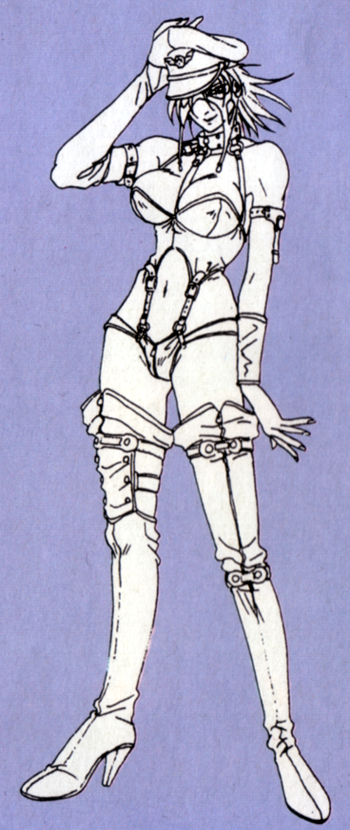Street Fighter II: The Animated Movie was also close to Capcom’s vision for the games, and so pieces of it turned up in later Street Fighter titles, particularly the Alpha series. Ken, Ryu, Cammy, and several other characters had their looks tweaked in accordance with the movie, and Alpha 2 recreates some of the film’s battles. One character from the film even crossed over: Senoh, M. Bison’s bald scientist crony, pops up in one or two Alpha endings.
There’s another piece of obscurity attacked to Street Fighter II: The Animated Movie. One character, also an agent of Bison’s Shadaloo syndicate, was on the drawing boards but never made it into the film. Her absence was noted in an old issue of Anime UK, and the magazine ran a sketch of her with this description: “In the outline, she worked for SHADOWLAW [Shadaloo] and appeared on the stage in Las Vegas wearing what one Japanese source describes as ‘radical bondage gear.’” Presumably, she was inspired by the showgirls that mill about in the background of Balrog’s stage in the original Street Fighter II.

Had she actually made it into the film, the unnamed dancer might’ve also slipped into the Street Fighter games and their loosely structured canon, which Capcom makes up only when circumstances and lawsuits demand.
Or maybe the dancer and her radical bondage getup aren’t so lost. With her Bison-like hat, she bears a certain resemblance to Poison, the Final Fight regular who was changed into a guy for the Super NES version of the game. Poison’s backstory has described her as both a cross-dressing man and a fully transgendered character, and the inconsistency has started far more fan debate than it probably should have. And now Poison’s in Street Fighter X Tekken, which will stir up even more debate. Of course, Poison is a non-existent video-game character and is therefore without any gender, but pointing that out makes you a jerk.

Was the dancer a Poison cameo that Manga UK didn’t notice? Or was she just some background filler that the story didn’t want or need? Whatever the answer, she’s still the most obscure of all unused Street Fighter characters, even more so than those early drawings of Dhalsim with six arms and an elephant’s head.

